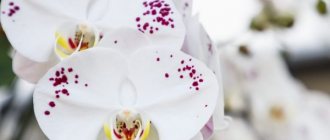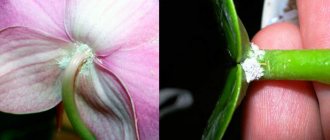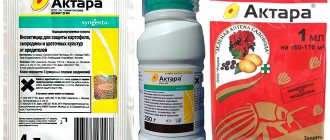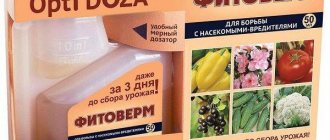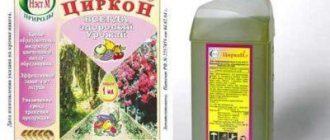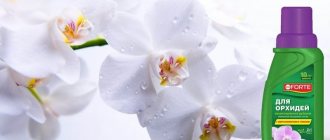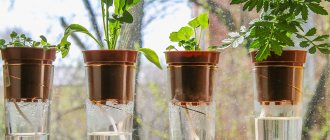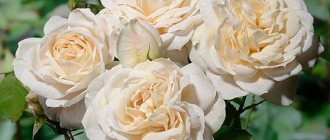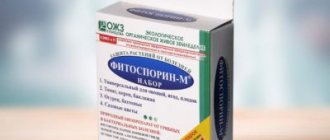Home / Preparations and fertilizers
Back
Published: 06/18/2019
0
3.9/5 — (19 votes)
Aktara is one of the most popular and widespread insecticides among gardeners and gardeners. A wide range of applications and proven effectiveness against most pests are the undoubted advantages of the drug. Like any chemical, Aktara has limitations that should be considered before use.
- 1 Composition and principle of action
- 2 Scope of application
- 3 Advantages and disadvantages
- 4 Release forms
- 5 Security measures
- 6 How to prepare a solution
- 7 Use for different types of crops
- 8 Processing of seedlings
- 9 Compatibility of Aktar with other drugs
- 10 Actions in case of poisoning
- 11 Reviews
Composition and principle of action
The active ingredient of the drug is thiamethoxam. In small doses, the synthetic compound causes stimulation of the nervous system of pests. Significant concentration leads to paralysis. Aktara belongs to the group of contact-intestinal insecticides. The substance is absorbed into the plant tissue, along with the cell sap enters the gastrointestinal tract of the insect and provokes its death. Pests with thin cover die after contact with the drug. Actara's effect does not apply to eggs, pupae and larvae.
The insecticide is used in 2 ways: spraying the ground parts of garden, vegetable and indoor crops and watering at the roots. In the first case, the solution is absorbed by the shoots in a matter of minutes. When applied to the soil, it takes several hours for the active substance to be distributed throughout all the vascular tissues of the plant. For fruit trees, this time is on average 1-3 days; for low-growing crops, 2-3 hours are enough.
Thiamethoxam mainly accumulates in plant leaves; its concentration in fruits is insignificant. The protective function of the drug lasts for 2-3 weeks after foliar treatment and 2.5-3 months after watering the soil.
How to get rid of thrips using folk remedies?
Folk remedies for thrips on indoor plants are low in effectiveness. In the case of using folk remedies, pest control becomes longer and more dangerous.
- The editors of the Flower Festival magazine believe that they can only be used when the pest population is small, when you quickly discovered it.
Therefore, it is possible to fight the pest with folk remedies only in rare cases, since it is difficult to detect in the first days of infection. If you still decide to fight thrips with folk remedies, then it is very important to observe regular processing and carry it out especially carefully.
1. Soap solution
To prepare a soap solution, it is better to take laundry, tar or green potassium soap, and, in extreme cases, dishwashing detergent.
The entire indoor flower, as well as the window sill, window frame, pot and pot tray are treated with a soap solution. The more foam in the process, the better.
After wiping the plant, it is better to wash off the soap suds after 2-4 hours.
RECIPE. Pour a tablespoon of soap shavings into a glass of warm water. To enhance the effect, you can add a teaspoon of ammonia (technical, medical, or, in extreme cases, vodka) and 300 grams of water.
The soap-alcohol solution must be washed off after 10-15 minutes with warm water so as not to burn your home flower.
IMPORTANT! Some experts insist that using soap solution on indoor flowers is not permissible. In their opinion, soap blocks the stomata of the plant, which leads to disruption of photosynthesis and plant development.
Plants with delicate leaves should not be treated with alcohol.
2. Pepper infusion
Infusion of red hot pepper: boil 20-30 grams of crushed (finely chopped) pepper in 200 ml of water for 60 minutes. Then leave the resulting liquid for 24 hours and strain. To spray, dilute 10 ml of infusion in a liter of water.
You can treat plants with pepper infusion once every two weeks. Pepper tincture can be stored for a long time in its finished form, which allows it to be used very quickly.
3. Tobacco
Pour 80 grams of dry tobacco (shag) with a liter of water and leave for 24 hours, then strain and dilute with a liter of water. Then rinse and spray the plant.
4. Mustard
Add a teaspoon of dry mustard powder to a liter of water and stir. Pour the resulting solution into the soil mixture - it does a good job of destroying pupated thrips larvae.
5. Garlic
Garlic infusion is a popular folk remedy in the fight against various pests.
Pour a glass of water over five crushed cloves (a teaspoon of pulp) of garlic. Infuse the mixture in a tightly sealed container for 1-2 days, and then wash the plant every 7-8 days. To spray, strain the infusion through three layers of gauze.
Recipe No. 2. A teaspoon of garlic pulp (4-5 cloves crushed) is poured into 500 ml of boiling water and left for 4-5 hours. The infusion is filtered and the affected flower is wiped.
6. Onion
A medium-sized onion is finely chopped, mashed and poured with a glass of water for 2-3 hours. Then everything is the same as with garlic.
ONION PEEKS. To prepare the infusion, pour 20 grams of husk with a liter of warm water and leave for 13-16 hours. The resulting infusion is sprayed on indoor flowers; usually 2-3 procedures are enough to remove aphids.
7. Celandine
300-400 grams of fresh celandine during flowering (or 100 grams of dry), leave in a liter of water for 24-36 hours and can be washed and sprayed.
8. Oil
Beat 5-10 grams of soap in a glass of water until foam appears, add 15-20 ml of machine oil (2 tablespoons of olive or sunflower). The plant is washed completely with a soap-oil emulsion and left for 6-10 hours, and then washed off.
Carry out 2-3 procedures every 7-10 days. Before treating the plant, cover the soil mixture in the pot with film! Treatment with a water-oil emulsion is not recommended for plants with pubescent, delicate or very thin leaves.
9. Kerosene
In a liter of water, stir 40 grams of household soap (25 grams of green potassium soap) and add five drops of kerosene, and then shake the solution well. The mixture can be wiped or sprayed on the affected areas of the plant.
BIOLOGICAL METHODS
Experts note that thrips can be controlled with the help of certain types of predatory mites, predatory bugs and lacewings. However, this control method is more suitable for greenhouses and greenhouses.
Scope of application
The insecticide packaging shows a close-up picture of the Colorado potato beetle, a well-known enemy of potato beds. Despite this, the spectrum of action of the chemical is much wider. Aktara is used in the fight against aphids, whiteflies, thrips, scale insects and many other harmful insects. The effectiveness of protection against onion flies, cabbage flea beetles, and apple moths has been proven. Dangerous pests are controlled in several ways:
- spraying over the entire surface of the above-ground parts of plants;
- application to the soil in beds and in bowls with potted plants;
- soaking the roots of vegetable seedlings;
- treatment of tubers before planting in the ground.
Aktara liquid
Liquid Aktara for the Colorado potato beetle is available in 9 ml bottles or 1.2 ml ampoules. This is a suspension with a concentration of the active substance thiamethoxam of 240 g/l.
Despite the fact that the Colorado potato beetle is depicted on the packaging and is mentioned in the title, liquid actara destroys all pests except mites: aphids, thrips, whiteflies, scale insects, scale insects, false scale insects, poduras, fungus gnats, codling moths, copperheads, etc. The consumption rates are as follows the same as actara in granules.
Since liquid actara is available in 1.2 ml packaging, it is easier to count using a syringe. For example, for currants, dilute the entire ampoule (1.2 ml) in 6 liters of water, for onion flies - 1.2 ml in 3 liters of water, and to cure roses from thrips with actara, you need to dilute 1.2 ml in 750 ml of water.
Advantages and disadvantages
The insecticide is deservedly popular among gardeners. Aktara's strengths include:
- The speed with which the drug affects pests. Insects eat poisoned leaves and receive a lethal dose of a toxic substance, which within half an hour provokes paralysis, subsequently leading to death.
- Effective against a wide group of pests, including insects that parasitize the back side of foliage.
- Absence of the unpleasant odor characteristic of most insecticides in dissolved form. For this reason, Aktar can be used in residential areas to treat indoor plants.
- Weather resistant. Efficiency does not decrease in heat and under the influence of ultraviolet radiation. After absorption, the drug is not washed off by precipitation.
- Safety for humans if precautions are taken.
- Toxic substances are not concentrated in the fruits of treated crops; therefore, hygienic safety is not compromised.
- Compatibility with other drugs aimed at protecting against harmful insects, fungal diseases, stimulating plant growth.
How to treat violets against midges?
Spraying with a weak solution of potassium permanganate, add 0.3-0.5 g of powder to a liter jar of water; After watering with soapy water, dissolve 1/3 of a piece of laundry soap in a liter of water; Treating violets with garlic infusion: pour boiling water over 3 heads of garlic and let it brew.
Interesting materials:
Who approves the staffing table of an educational institution? Who approves the staffing schedule of an educational organization? Who approves the composition of the commission to investigate a group accident during the operation of a production facility controlled by Rostechnadzor? Who is in the European Union? Who maintains the executive documentation? Who maintains a personal record card for issuing PPE? Who maintains the register of shareholders in the CJSC? Who are the officials? Who is on the minor accident investigation committee? Who is included in the mot?
Release forms
The development of the drug belongs to the Swiss company Syngenta. In the Russian Federation, Aktara is produced under license. There are several forms of release on sale:
- water-dispersible granules (WDG) packaged in 1.4 g, 4 g and 250 g;
- liquid suspension in ampoules of 1.2 ml and polymer bottles of 9 ml and 1 l.
As a rule, one package of the minimum quantity is enough for processing garden and vegetable beds on individual farms and for use at home to protect indoor flowers. Large packaging is intended for the use of insecticide on an industrial scale.
Stable demand and high cost of Aktara have given rise to a market for counterfeit drugs. To protect yourself from unscrupulous manufacturers, you should know the characteristic features of the original drug:
- the hologram applied to the packaging has a denser structure and is completely separated from the surface;
- the Syngenta logo is visible in the center of the hologram; if you change the viewing angle, the Aktara inscription appears;
- The original packaging contains state registration numbers and container labels (for those licensed in the Russian Federation).
In Russia you can purchase registered analogues of the insecticide, which also contain thiamethoxam: Tiara, Eforia, Doctor Cruiser and Adamant.
The shelf life of granules is 4 years, ampoules - 12 months. The chemical is stored in a sealed condition at a temperature range of 10°C to 35°C, out of the reach of children and pets.
How to deal with thrips on indoor plants?
Fighting thrips is not an easy task, as they are insidious pests. To get rid of them at home, you need to use effective control methods, which are a set of actions.
COMBAT MEASURES
- If thrips are found, trim off all buds and flowers, especially on a flowering plant.
- Carefully move the plant away from the rest of the flowers and carefully inspect the entire home collection. Wash the place where the affected plant was located (window sill, window, outer sides of pots) with a soap-alcohol solution.
- Replace the top layer of substrate.
- Before treating with the drug, first wash the plant in the shower or with a cotton swab, cloth or soft toothbrush with a solution of water and methyl alcohol (1:1), soap solution or tobacco infusion to wash off the thrips.
- Rinse off the solution and leave the plant to dry. After the water has evaporated from the leaves, we spray the plant, the top layer of soil and water the soil with a systemic insecticide as one of the stages of thrips development takes place in the soil.
- Ventilate the room well.
ADVIСE. Unfortunately, rinsing in a hot shower does not kill thrips.
Types of plants whose leaves cannot be washed must be sprayed, preferably with preparations.
With the help of these recommendations, treatment of indoor plants is more successful. These methods of combating thrips have helped many gardeners and saved many indoor flowers.
.
Thrips larvae and adults
.
Security measures
Aktara belongs to low-toxic drugs of class 3 hazard for humans and mammals. To completely eliminate the risk of poisoning and burns, you must strictly adhere to the instructions and follow certain technology:
- when working with the substance, use gloves, a mask or a special respirator;
- manipulations with the insecticide are carried out in an open space; when working in a living room, a window is opened;
- refrain from drinking water, food and smoking at the time of contact with the drug;
- after use, burn the container of the used solution;
- After finishing all the work, wash your hands thoroughly and rinse your face.
Precautionary measures
This chemical belongs to hazard class 3 and is moderately dangerous.
The drug kills not only harmful, but also beneficial insects, in particular bees. Therefore, Aktar is not used during the flowering period of garden and vegetable crops. Also, be careful when spraying the drug near water bodies so as not to harm aquatic life.
When treating plants with Aktara, some protective measures should be taken:
- children and pets must be removed from the work site;
- When spraying, you must use personal protective equipment;
- from the moment of dilution of the Aktara working fluid and until the end of the treatment, it is prohibited to eat, drink or smoke;
- Make sure that the product does not get on the skin or inside. If signs of illness appear, you should contact the clinic;
- carry out treatment for 2.5-3 hours.
Important!
The remains of the Aktara solution prepared for treatment cannot be stored; they are disposed of along with household waste. Do not pour into a sewer or pond.
Compatibility of Aktara with other products This drug is compatible with other insecticidal and fungicidal agents. There is no data on the incompatibility of Aktara with growth stimulants.
How to prepare the solution
Aktara is easily soluble in water, but to prepare a working solution from dry granules, some nuances should be taken into account:
- pre-prepare containers for mixing the required volume and check the serviceability of the sprayer;
- the prepared solution cannot be stored, so the required amount of granules is immediately measured, which depends on the crop being treated;
- the contents of the package are diluted in a small amount of water (temperature not lower than 25 °C);
- shake thoroughly until the liquid structure is homogeneous;
- add the solution to the required volume, mix again;
- Liquid Aktara in ampoules is prepared according to a similar principle.
After these manipulations, the drug is ready for use. Plants should be sprayed in cloudy (but not rainy) weather. When the need to treat against a pest does not allow you to hesitate, and there is a likelihood of precipitation, you should spray the plants no later than an hour before the rain. On sunny days, early morning or after sunset is suitable for processing.
Description of the product
Aktara for indoor plants is a new generation anti-insect substance belonging to the class of neonicotinoids. These substances act on nicotinic receptors in the insect's nervous system. This class was named based on this principle. The plant protects for 14-60 days.
Aktara is a popular insecticide
The drug does not have a harmful effect on cultivated crops and flowers. If the rules of use are followed, it does not harm humans, since it does not penetrate into the fruit. It is distributed throughout the leaves through the vascular system.
The time frame for reaching the maximum concentration of a substance in a plant differs depending on the method of administration. If a liquid solution was sprayed, it spreads completely over the leaf within 20 hours. When watering, the insecticide gets into the upper shoots within three days (maybe earlier, it all depends on the conditions of the plant, its type and a number of other parameters).
Aktara in dry and liquid forms
The effectiveness of the drug does not depend on the amount of sun, rain or dry weather falling on the flowers. Its duration depends on the method of treating orchids with Aktara. If the plant has been sprayed, it is protected for 2 to 4 weeks. When watered, the drug lasts longer - from 40 to 60 days.
With repeated use, insect resistance to the drug may develop. Thus, repeated invasions of whiteflies and scale insects are very often observed. The reason for relapses is that Aktara affects the larvae (which feed on the plant). If you do not properly moisten the root ball, some of the larvae will remain in the ground. With each watering, the amount of insecticide decreases and the plant loses protection.
To prevent orchids or other plants from developing resistance to Aktara, it is recommended to combine it with insecticides with a different principle of action. Aktara goes well with most toxins for insect pests.
Aktara in ampoules
The maximum shelf life of Aktara is 4 years. The composition must not be allowed to freeze. The minimum storage temperature is -10 degrees.
Use for various types of crops
The standard bag contains brief instructions for using Aktara for plant protection. The concentration varies depending on the specific crop and type of treatment.
| Culture | Pest | Drug consumption |
| Potato | Colorado beetle | 1.2 g per 10 liters of water. Spray once. Waiting period 14 days |
| Currant | Aphid | 2 g per 10 liters of water. Spray before flowers appear, re-spray after harvest |
| Tomatoes, eggplants, sweet peppers | Aphids, Colorado potato beetles, whiteflies, leafhoppers | 1.4 g per 10 liters of water. Spray once after an attack by pests 4 g per 10 liters of water for application to the soil |
| Cabbage | Aphids, flies and flea beetles | 3 g per 10 liters of water. One-time spraying. Waiting period 3 weeks |
| cucumbers | Aphids, whiteflies, tobacco thrips | 2 g per 10 liters of water. Spray once until buds appear. 8 g per 10 l for application to the soil |
| Grape | Cicadas | 3 g per 10 liters of water. Single spraying |
| Apple tree | Codling moth, aphid, copperhead | 3 g per 10 liters of water. Spray once before or after flowering. |
| Fruit trees | Aphids, codling moths, honey moths, scale insects | 4 g per 10 liters of water. Spray once before or after flowering. |
| Potted crops | Aphids, scale insects, whiteflies, flies, false scale insects | 1 g per 10 liters of water. Spraying in case of pest attack. 0.8 g per 1 l. Application into the soil after moistening the soil. |
Helpful information! If the bag contains more drug than is required for a single treatment, the granules are poured onto a paper sheet and divided into equal portions using a toothpick. The required amount is used for further preparation. The remaining “piles” are poured into plastic bags with an airtight closure.
Purpose of the drug
Aktara is intended for use as an insecticide from the neonicotinoid group. It is effective in getting rid of thrips, scale insects, whiteflies, scale insects, false scale insects, the Colorado potato beetle on potatoes, as well as aphids that live on berries and flower crops. The product has a low effectiveness against whiteflies, but has virtually no effect on arachnid pests.
Suitable for house plants. Does not affect resting puparia larvae, pupae, insect eggs, adults (non-feeding adults).
Processing of seedlings
Aktars are often used to treat potato tubers before planting in open ground and for preventive treatment of seedlings. The procedure is carried out before planting seedlings in a permanent place. The procedure is as follows:
- 1.4 g of Aktar granules are dissolved in 1 liter of warm water;
- seedlings of tomatoes, peppers, eggplant are soaked in the solution for 2 hours so that the roots of the seedlings are evenly wetted with the liquid;
- no later than 12 hours after treatment, the plants are planted in the ground.
To process potato tubers, use 6 g of granules diluted in 0.5 liters of water. The planting material is laid out on polyethylene and sprayed with the resulting solution using a spray bottle. Wet tubers are mixed to evenly distribute the substance and immediately planted in the beds. Potatoes processed in this way are not stored.
Preparation of Aktara working solution
The working solution of Aktara insecticide is prepared as follows: the contents of one ampoule are dissolved in a small amount of water and mixed well.
Then water is added to this working fluid to the required concentration. On a note!
Spraying of plants is carried out in the evening hours, when there is no wind or rain. The air temperature should be about 13-22 degrees Celsius. Typically, mass death of insects occurs after about 5-6 hours.
Compatibility of Aktar with other drugs
One of the advantages of Aktara is that the drug can be used in combination with most herbicides, pesticides, and growth stimulants. This property allows the insecticide to be used in tank mixtures. Gardeners combine Aktara with Fitosporin M, Epin and Zircon. Before use, it is advisable to conduct a compatibility test of the active ingredients. To do this, mix a small amount of drugs and observe the consistency of the resulting solution. If sediment appears at the bottom, there is no practical point in using the mixture.
Composition of the drug, similar products
The active substance included in this insecticide is thiamethoxam. It makes up ¼ of the mass of this chemical. “Aktara” enters the vegetative mass either through the skin of the leaves, or is absorbed by the root system from the soil when watered with an insecticide solution. It then spreads along the stem throughout the plant.
Instructions for use
After the drug has spread throughout the plant, it is no longer afraid of either rain or hot weather - it has already been absorbed by the plant and has begun to work.
If this product is not available in a specialized store, then sellers can offer the following analogues:
- Tiara;
- Adamant;
- Cruiser;
- Doctor.
Actions in case of poisoning
When working with the drug, it is necessary to avoid contact in every possible way with both granules and suspension, and with the working solution. Otherwise, you need to act immediately:
- if drops of the solution get on the skin, they must be thoroughly washed off with a detergent;
- If the chemical gets into your eyes, rinse with cool water for at least 5 minutes;
- If it enters the digestive system, you should take the absorbent and drink plenty of water.
Symptoms of insecticide poisoning include nausea, swelling of the eyelids, and dizziness. In this case, it is recommended to seek medical help.
Aktara reviews
In general, Aktara is very popular among flower growers, gardeners and gardeners. Almost alone, it holds the palm among insecticides. Firstly, the drug does not have a pungent odor, like all others. Secondly, because the drug is systemic - it spreads from the juices throughout the plant and destroys the pest if you simply water it, i.e. Spraying is not necessary, although it is advisable. The fact is that mealybugs, and these include mealybugs, rootbugs and scale insects, are very tenacious (they are protected by a shield or a wax coating). And when sprayed, actara cannot always penetrate deeply into the lower layers of the epidermis.
Therefore, one spraying is not enough against this group of pests, especially on plants with dense, leathery leaves or fruits. Here, only simultaneous spraying and watering with actara is effective. In this case, the treatment must be repeated after 10-12 days.
Attention: Rosselkhoznadzor warns about fake aktar.
Toxicity
Aktara has a hazard class - 2 or 3 (hazardous substance, the class depends on the concentration), hazard class 1 for bees (border protection zone for bees 4-5 km). Thiamethoxam is slightly toxic to birds, fish, earthworms and aquatic organisms. Not phytotoxic.
Waiting time - the time after treatment before harvesting is 14–21 days when spraying any crops and 40–60 days when watering the soil.
Security measures
Handle using gloves. While working, you must not smoke, drink, or eat. After work, wash your face and hands with soap and rinse your mouth. Store the drug in a cool, dry room at a temperature from -10C to +35C, separate from food and medicine, out of the reach of children and pets! Storage of the working solution is not allowed.
First aid for poisoning: if the drug gets on the skin, wash off with soap and water; In case of contact with eyes, rinse thoroughly with running water; if it enters the digestive tract, drink 3-4 glasses of water, induce vomiting, take several tablets of activated carbon, seek medical help. Symptoms of acute poisoning include ptosis of the eyelids, decreased motor activity, and tonic and clonic convulsions.
